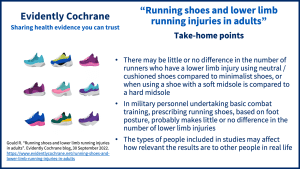In a blog for people who run for exercise, Dr Rebecca Gould, Cochrane UK Fellow and Sport and Exercise Medicine Registrar, looks at the evidence on the role of running shoes for preventing lower limb running injuries and explores some of the considerations needed when applying the evidence from research studies to real life.
Take-home points
Running is one of the most popular forms of exercise worldwide and, like physical activity in general, it is associated with a wide range of health benefits. However, in all runners, from those taking their first strides, to elite athletes, running-related injuries can occur. What part, if any, do running shoes play in this? There is a huge variety of running shoes available. It’s not uncommon for shoe manufacturers or shops to recommend a particular style of running shoe, based on someone’s foot type or running style (gait), to try and reduce the chance of injury, but is there evidence to back up these claims?
A quick introduction to running injuries
AcuteA health condition (or episodes of a health condition) that comes on quickly and is short-lived. injuries occur after a sudden event, for example rolling your ankle. Muscles, tendons, and bones like to be used and will adapt positively to new loads which are increased gradually (for example, gradually increasing running distances, or strength training). However, if the increase in load is too great, the tissues are not able to respond appropriately, and a chronicA health condition marked by long duration, by frequent recurrence over a long time, and often by slowly progressing seriousness. For example, rheumatoid arthritis. (otherwise known as overuse) injury may develop. Overuse injuries include conditions such as tendinopathy, patellofemoral knee pain, medial tibia bone stress (shin splints) and stress fractures.
Running shoes have been proposed as a possible way to reduce the riskA way of expressing the chance of an event taking place, expressed as the number of events divided by the total number of observations or people. It can be stated as ‘the chance of falling were one in four’ (1/4 = 25%). This measure is good no matter the incidence of events i.e. common or infrequent. of chronic running injuries. Different theories as to how they may do this have been suggested, for example by controlling foot motion, or changing how the forces associated with running are distributed through the structures of the foot and leg.
The evidence on running shoes
A recent Cochrane ReviewCochrane Reviews are systematic reviews. In systematic reviews we search for and summarize studies that answer a specific research question (e.g. is paracetamol effective and safe for treating back pain?). The studies are identified, assessed, and summarized by using a systematic and predefined approach. They inform recommendations for healthcare and research. Running shoes for preventing lower limb running injuries in adults (published in August 2022) has looked at randomizedRandomization is the process of randomly dividing into groups the people taking part in a trial. One group (the intervention group) will be given the intervention being tested (for example a drug, surgery, or exercise) and compared with a group which does not receive the intervention (the control group). controlled trialsA trial in which a group (the ‘intervention group’) is given a intervention being tested (for example a drug, surgery, or exercise) is compared with a group which does not receive the intervention (the ‘control group’). investigating whether different types of running shoes can prevent injuries in adults who run. The authors compared different types of running shoes (based on their design features) and also examined if prescribing a particular design of running shoes, based on the shape of the foot, made a difference to lower limb injury rates. Here’s what they found:
Different types of running shoe
- There may be little or no difference in the number of runners who experienced a lower limb injury using neutral / cushioned shoes compared to minimalist shoes.
- There may be little or no difference in the number of runners who experienced a lower limb injury using shoes with a soft midsole, compared to a hard midsole.
- They were uncertain whether there was any difference in the number of runners who experienced a lower limb injury when motion control or stability shoes were compared to neutral/ cushioned shoes, or motion control shoes were compared with stability shoes.
Running shoes prescribed based on foot shape
- Prescribing running shoes, based on foot posture, probably makes little or no difference in the number of lower limb injuries.
What does this mean for you and me?
After nearly a decade-long hiatus I’ve recently decided to try and add running back into my weekly routine and whilst checking out the rows and rows of trainers in the local running shop I was thinking of this review.
One of the key questions when using evidence to make decisions is to ask ‘can the results be applied to me?’. Many factors affect this answer, but one thing it’s important to consider is “how similar to the people who took part am I?” If you are very different to the people who took part in the research, the results may not apply to you.
So when I’m looking at the evidence on running shoes based on foot shape, I need to bear in mind that it comes from research studies where all the people taking part were military personnel taking part in basic combat training. This is a quite different group of people, likely experiencing quite different demands, compared to recreational runners like me. It might be more accurate to say that in military personnel doing basic combat training, prescribing running shoes, based on foot posture, probably makes little or no difference in the number of lower limb injuries. But it is uncertain if this is the same for recreational runners – we don’t have evidence on this.
Drawing firm conclusions about the effects of different types of running shoes is also difficult. Firstly, the evidence is low- or very low-certaintyThe certainty (or quality) of evidence is the extent to which we can be confident that what the research tells us about a particular treatment effect is likely to be accurate. Concerns about factors such as bias can reduce the certainty of the evidence. Evidence may be of high certainty; moderate certainty; low certainty or very-low certainty. Cochrane has adopted the GRADE approach (Grading of Recommendations Assessment, Development and Evaluation) for assessing certainty (or quality) of evidence. Find out more here: https://training.cochrane.org/grade-approach which means the true effect (what actually happens) may be markedly different from the effect estimated by the studies. Also, the types of runners included in the studies varied a lot. Some studies only included men, some included runners who could run continuously for 20 minutes, and others 60 minutes. Other studies were in runners training for a 10km or half-marathon. As you can imagine, this variability makes it difficult to generalise results to a large proportion of runners in real life.
So, did I use this review to decide on which running shoe to buy? In a way yes – as the evidence doesn’t support using one type of shoe over another, I just went for a pair that felt comfortable and I liked to look of!
Join in the conversation on Twitter with @CochraneUK and @DrRebeccaGould or leave a comment on the blog.
Please note, we cannot give specific medical advice. We do not publish comments that link to individual pages requesting donations or to commercial sites, or appear to endorse commercial products. We welcome diverse views and encourage discussion. However, we ask that comments are respectful. We reserve the right to not publish any we consider offensive. Cochrane UK does not fact check – or endorse – readers’ comments, including any treatments mentioned.
The Cochrane Review: Relph N, Greaves H, Armstrong R, Prior TD, Spencer S, Griffiths IB, Dey P, Langley B. Running shoes for preventing lower limb running injuries in adults Cochrane Database of Systematic ReviewsIn systematic reviews we search for and summarize studies that answer a specific research question (e.g. is paracetamol effective and safe for treating back pain?). The studies are identified, assessed, and summarized by using a systematic and predefined approach. They inform recommendations for healthcare and research. 2022, Issue 8. Art. No.: CD013368. DOI: 10.1002/14651858.CD013368.pub2.
Rebecca has nothing to disclose.



